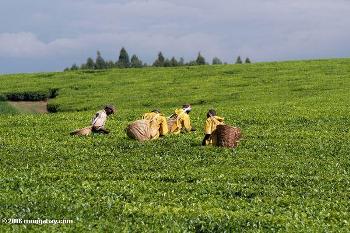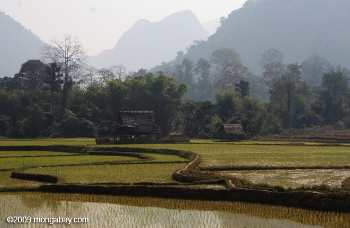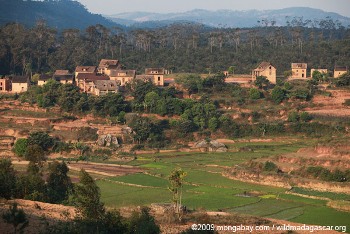Will it be possible to feed nine billion people sustainably?

Obstacles
The difficulties are many and large, according to the paper: "growing competition for land, water and energy, and the over-exploitation of fisheries, will affect our ability to produce food, as will the urgent requirement to reduce the impact of the food system on the environment."
The finiteness of arable land and freshwater will be further strained by what the authors call "higher purchasing power", which increases the demand in the developing world for "processed food, meat, dairy and fish, all of which adds pressure to the food supply system."
 Soy and forest in the Amazon. Photo by: Rhett A. Butler. |
"Projections of food needs over the next 40 years have generated deep concern about how agricultural production can increase sufficiently in the face of climate change threats," explains co-author Dr. Camilla Toulmin from the International Institute for Environment and Development. "Not only will rising temperature and shifts in rainfall patterns render crop production more uncertain in many areas, but the agricultural sector will need to become a better sink for carbon, through sequestration, while reducing emissions of greenhouse gas such as nitrous oxide, which is produced from use of chemical fertilizers."
She adds that the availability of arable land is further constrained by the "need to maintain and improve the carbon stores held in forests, which also contribute to the world’s water balance, biological and cultural diversity, so expansion of farming into forest and grazing lands is not a sensible option."
Given all of these issues, the authors conclude that "a three-fold challenge now faces the world: match the rapidly changing demand for food from a larger and more affluent population to its supply; do so in ways that are environmentally and socially sustainable; and ensure that the world’s poorest people are no longer hungry."
Simply impossible?
The problem appears insurmountable, but the authors say that with 'radical' changes worldwide it is possible to feed nine billion people without destroying the environment that makes such agriculture possible.
 Tea workers in Uganda. Photo by: Rhett A. Butler. |
Noting that farmers around the world are constrained by lack of "access to the technical knowledge and skills required to increase production, to the finances required to invest in higher production […] or to the crop and livestock varieties that maximize yields," the authors argue that governments and institution must work to give greater and easier access for farmers—especially in the developing world—to the tools needed to increase yields. Investment is especially needed in the world's poorest countries to aid small farmers, including reaching out specifically to women agriculturalists, to increase yields and thereby income.
The authors also recommend pushing production limits. To do so agriculture must emulate the green revolution by developing new strains of crops that are more disease resistant, require less water, and produce more food. Furthermore, they argue that corporations must make genetically-modified (GM) crops widely available, while still maintaining competitiveness. Of course, the use of GM crops remains very controversial.
"Our view is that GM is a potentially valuable technology whose advantages and disadvantages need to be considered rigorously on an evidential, inclusive, case-by-case basis: that it should neither be privileged nor automatically dismissed," the authors write.
 Rice fields in Luang Prabang province in Laos. Photo by: Rhett A. Butler. |
The authors point out that the problem of wasted food in the industrialized world is complex.
"Food is at present relatively cheap, at least for these consumers, which reduces the incentives to avoid waste. Consumers have become accustomed to purchasing foods of the highest cosmetic standards and hence retailers discard many edible yet only slightly blemished products." In addition: "the food service industry frequently uses 'supersized' portions as a competitive lever, while 'buy one get one free' offers have the same function for retailers. Litigation and lack of education on food safety has lead to a reliance on 'use by dates' whose safety margins often mean that food fit for consumption is thrown away."
Waste also occurs in the developing world, but for different reasons: here "losses are due mainly to the absence of food chain infrastructure, and to lack of knowledge or investment in storage technologies on the farm," according to the paper.
The authors recommend that in the developing world investment is needed for better transportation and storage related to food. For the industrialized world, education, advocacy, legislative changes, and cultural shifts are required to stem the massive amounts of wasted food.
In addition to increasing yields and reducing waste, the authors suggest society lessens meat consumption overall, while ensuring that livestock is raised efficiently. In regards to marine foods, the authors suggest increasing aquaculture, while at the same time working to mitigate the practices' environmental impacts. For example, they suggest aquaculture should focus on raising marine species lower on the food chain.
Final piece: sustainability
 Village and rice plots in Madagascar's Central Plateau. Photo by: Rhett A. Butler. |
To ensure sustainability the authors say that better 'metrics of sustainability' are first needed to evaluate the efficacy of strategies. According to the paper, sustainability need not threaten food security: studies have shown that sustainable farming does not mean reduced yields, in fact in many case studies employing sustainable practices actually increased yields.
"There is no simple solution to feeding sustainably nine billion people, especially as many become increasingly better off and converge on rich-country consumption patterns. A broad range of options, including those we discuss here, needs to be pursued simultaneously," the authors conclude. "We are hopeful about scientific and technological innovation in the food system, but not as an excuse to delay difficult decisions today."
Citation: H. Charles J. Godfray, John R. Beddington, Ian R. Crute, Lawrence Haddad, David Lawrence, James F. Muir, Jules Pretty, Sherman Robinson, Sandy M. Thomas, Camilla Toulmin. Food Security: The Challenge of Feeding 9 Billion People. Science. 28 January 2010. 10.1126/science.1185383.
Copyright
mongabay
2010 To subscribe
or visit go to:
http://news.mongabay.com